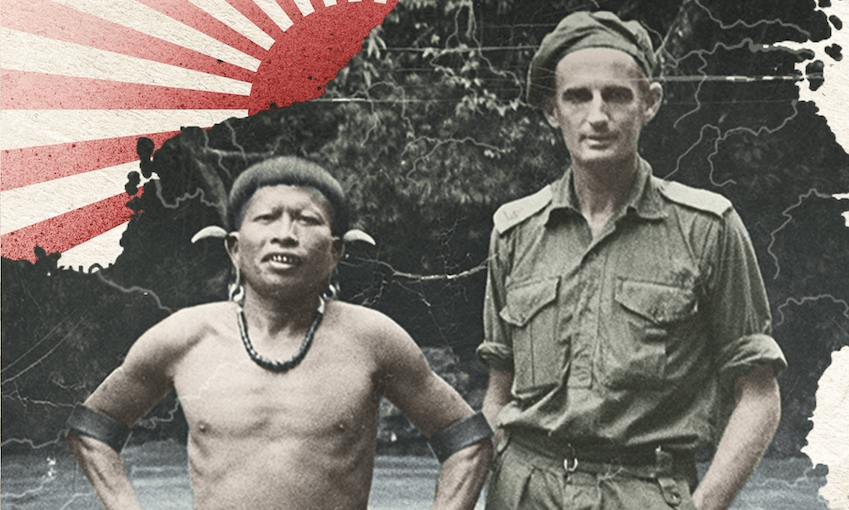Christopher Tremewan reviews Semut, a remarkable war story by New Zealand academic Christine Helliwell.
Borneo has long occupied a fevered place in the western imagination, largely owing to the headhunting tradition of various tribes.
But, in 1968, as a widely untravelled 17-year-old Christchurch schoolboy, I knew little of this. I couldn’t even find on a map the small river town in upcountry Sarawak where Volunteer Service Abroad planned to send me to teach for a year.
Sarawak, now heavily logged, was then covered in virgin rainforest accessed by winding tropical rivers leading through hill country to the cool highlands. I could travel upriver for days in longboats through primal forests, with the Dayak students I was teaching, to visit their longhouses. We hauled the boats up dangerous rapids and fished for lunch in clear pools.
The preserved heads still hanging in the rafters of some longhouses spoke to the deadly success of the audacious, and at that time secret, Operation Semut. Now a book grounded in decades of ethnological fieldwork tells a richer story of this military manoeuvre.
Located on the north-west coast of Borneo, the third largest island on the planet, Sarawak has a land area about the same as the South Island. Adding a dose of colonial nostalgia, Sarawak was once the personal domain of a three-generation dynasty of British “white rajahs”.
From 1841, James Brooke began his family’s rule over the forest-dwelling indigenous tribes, coastal Malay villages and Chinese towns of Sarawak. The Brookes lasted a century, until the Japanese invaded in December 1941. Six weeks prior, Rajah Charles Vyner Brooke, GCMG, decamped “on holiday” to Australia, having withdrawn £200,000 from the treasury. (His nephew and crown prince, Anthony, ended up living out forced retirement in Whanganui, where he died in 2011.)
During the last months of the war, Britain prepared to reassert its claim to this corner of empire for geostrategic reasons (read: the oil fields in Brunei and offshore Sarawak).
US General Douglas MacArthur, supreme allied commander in the Pacific, was against any British move into Borneo. When he was preoccupied with re-taking the Philippines, the British took the opportunity to secretly parachute a small special ops force of Brits and re-patched colonials (mostly Australians) led by a self-effacing New Zealander, into the Sarawak jungle behind Japanese lines.
The aim was to surprise the Japanese forces stationed in the downriver and coastal towns by attacking them from the jungle interior. They planned to do this in concert with tribes newly released from the prohibition on headhunting – provided the heads were Japanese.
This all sounds like the staging for a racist colonial pot-boiler: sound British chaps take back power from the insidious Japanese in order to resume ruling benignly over the natives.
Precisely because of its refusal to come anywhere near this genre, Semut, a carefully researched account of this secret military operation of the same name, delivers extraordinary narrative punch.
Christine Helliwell, a New Zealander, is an anthropologist at the Australian National University. She has decades of research in Sarawak under her belt, and had no desire to become a military historian. But when nudged by Jack Tredea, a 94-year-old veteran of the operation who has since died, she began to see the promise of telling this story – centering the local people as the key actors.
As the operatives of Semut were sworn to lifelong secrecy and many documents have been destroyed, this was not an easy history to write. But Helliwell’s forensic persistence has resulted in a compelling book (the first of two volumes she’s planning), brought to life by the depth of her understanding of Sarawak and its people caught in the crosshairs of imperialism, both British and Japanese.
She makes it clear the operation could not possibly have succeeded without the support of the Dayak peoples, tribes who knew the rainforest intimately over vast unmapped areas. There was no guarantee that they would rush to the side of their former colonial masters, despite the harshness of Japanese military occupation. As she writes:
“[Kenyah paramount chief] Tama Weng proved to be shrewd and well-informed about the course of the war. Like many other Dayak leaders he had been wooed by the Japanese; however, he had managed to maintain a careful neutrality, assisted by the distance of his longhouse from centres of Japanese authority downriver. He knew that joining Carter’s operation would mean repudiating the safety of that neutrality and committing not only his own remote longhouse, but longhouses under his chiefly authority up and down the river, to the dangers attendant on insurrection.”
After days of talks followed by days of nerve-wracking silence, the military operatives, who had returned to a small wooden fort overlooking the river, got their answer.
“Advancing downriver, was a flotilla of boats, led by Tama Weng’s great ceremonial canoe crammed full of his men. And at the stern, wonder of wonders, a large Union Jack – an astonishing sight given that any flags, other than Japanese, were prohibited in the territory under pain of death.”
Having made this decision, the agreement stuck.
“…in spite of the dangers that the presence of the [British operatives] posed to locals, as well as the $5000 price tag on each European head, the party was betrayed to the Japanese by no-one.”
It is the political acuity and strategic prowess – along with deadly effectiveness – of the Dayak peoples which informs and textures Helliwell’s book. Without that, Semut would be the story of a few soldiers stumbling around an unending tropical forest that most of them knew little about with people they knew even less about, and fearing both.
Navigating swiftly and silently through the forest over considerable distances, even at night, was normal for Dayaks. With their help, a wider range of guerilla operations quickly became possible. And jungle rendezvous were sometimes startling:
“Suddenly the first Dyak burst into the clearing … In his right hand he carried his long parang, the blade ominously stained dark, and in his left, held by one ear, the clearly recognisable head of a Japanese [soldier] … more Dyaks came charging through the undergrowth. The less flamboyant of them had the delicacy to carry the gruesome spoils of battle in sacks … they tipped up the sacks. A cascade of heads tumbled to the ground.”
In one instance the Ibans who had joined the operation observed new, covered air-raid trenches on the jungle margin near a Japanese position. They came up with a plan: to call in an air raid where their ability to move unseen and unheard could be used to maximum advantage.
“As [the planes] left, vapour trails drifting across the sky, the Ibans settled securely onto the roofs of the trenches, three to each trench. In the sudden silence after the raid, Japanese began to emerge from the shelters. As they did, the Ibans fell on them from above.”
Helliwell makes clear that the arrangement was never an easy one. The soldiers were frequently out of touch with their headquarters for long periods, and were often left without promised weaponry and supplies which could convince local leaders that there was a real substance to their promises. Helliwell tells the story as a constant negotiation between the military operatives and those tribal leaders who could give the outlandish plan a chance of success.
She also emphasises the cultural complexity in play.
“Unlike the Kayan, Kenyah, Sekapan and so on … Iban society is characterised by a ‘noisy, anarchic democracy’ under which every person is free to take part in discussions affecting the community as a whole … [M]omentous decisions involving more than one longhouse head demanded ongoing debate, with every longhouse head (along with many of his followers) airing his view. Consensus was achieved fleetingly, only to vanish again in a welter of argument and counter argument.”
Major Australian forces eventually moved down the coast of northwest Borneo and began to bomb Sarawak towns, some of which the Japanese had already vacated. Without reliable communications, the Semut operatives somehow had to inform this new force and its pilots that they had occupied the small upriver town of Kanowit. They used a highly visible arrangement of white painted planks.
“Dave Kearney [one of the Allied operatives] decided that … the message needed to be short but unambiguous. Moreover it was necessary to ensure such a message could not be misinterpreted as a Jap[anese] ruse … It was agreed that Dave’s final format would satisfy all conditions. It was set up on the riverside slope of the ridge between the District Officer’s bungalow and the Kubu [fort]. It read: FUCK OFF.”
But it is a surrender scene in a coastal town that captures the audacity of the whole venture. The Japanese commander has drawn up his immaculate troops behind a table covered in a white cloth. When a motley band of gaunt, bedraggled allied soldiers appears, some in shorts or loincloths, he realises too late – and with a burst of anger – that the massive force he had been led to believe was descending from the hills does not exist.
*
An irresistible sub-plot is provided by Major “Toby” Carter, the quietly competent New Zealand commander of the operation. A pre-war surveyor for Shell in nearby Brunei, Carter spoke Malay and snatches of some Dayak languages. He also had personal relationships with some of the more powerful upriver tribal chiefs. Yet being one of the few soldiers with extensive local knowledge counted for little with a subordinate and intensely competitive, self-promoting British officer, Tom Harrisson. Harrisson constantly – and eventually successfully – undermined Carter by lobbying his Cambridge chums back at headquarters.
Carter did get a richly-deserved Distinguished Service Order medal. And after a post-war stint back in Brunei, with Shell, he eventually worked for the Wellington Harbour Board.
When I return to Sarawak these days, it is bittersweet.
At considerable personal risk, BBC journalist Clare Rewcastle Brown (who was born in colonial Sarawak in 1959) has exposed the corruption around Sarawak’s deforestation, its link to the 1MDB scandal which brought down the Malaysian prime minister, and the continuing theft of land from indigenous tribes.
Most Dayaks now live in separate houses, often away from their ancestral lands. Google Earth shows vast areas logged and denuded by palm oil monoculture, with smudges of muddy torrents in the highlands where pristine rivers once sparkled. The rain forest is not silent. It is no longer there.
Semut: The Untold Story of a Secret Australian Operation in WWII Borneo, by Christine Helliwell (Michael Joseph, $40) can be ordered from Unity Books Auckland and Wellington.



